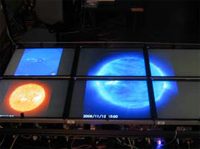Development of Display Environment for LASCO, EIT and SECCHI
July 10th, 2007
Categories: Applications, Government, Visualization

Authors
Kim, T.J., Krumbholz, C., Leigh, J.About
Researchers in the Solar Physics Branch at Naval Research Laboratory (NRL) have been involved in observational and theoretical studies of the solar atmosphere since the early years of the space age. They are viewing impressive solar disturbances whose depth and violent nature are now clearly visible in the first true stereoscopic images ever captured of the Sun. These new views, recently released by NASA, are providing scientists with unprecedented insight into solar physics and the violent solar weather events that can bombard Earth’s magnetosphere with particles and affect systems ranging from weather to our electrical grids.
The Electronic Visualization Laboratory (EVL) has helped establish a solar imagery display environment, two EVL-developed display systems capable of viewing and managing files on the scale of thousands of pixels per square inch: a 9-panel tiled LCD wall ideal for viewing high-resolution 2D imagery, and an ImmersaDesk4 for viewing high-resolution 3D imagery. The tiled display consists of 9 cinema LCD displays with an overall resolution of approximately 8k by 5k pixels and will be used to work with multiple HD quality video feeds, enabling multi-spectral analysis of synchronized image streams from sensors on each satellite. The ImmersaDesk4, invented at the University of Illinois at Chicago (UIC) Electronic Visualization Laboratory (EVL), is a tracked, 4-million-pixel display system driven by a 64-bit graphics workstation. Its compact workstation design is comprised of two 30-inch Apple LCD monitors mounted with quarter-wave plates and bisected by a half-silvered mirror enable circular polarization. It permits scientists to visualize the stereo imagery in high resolution 3D. Multiple users can view the head-tracked 3D scene using lightweight polarized glasses.
Solar physicists at NRL hope that this new technology will allow them to better visualize the three dimensional structure of coronal mass ejections and evaluate the impact these events have on the earth’s atmosphere.
Resources
Citation
Kim, T.J., Krumbholz, C., Leigh, J., Development of Display Environment for LASCO, EIT and SECCHI, Final Technical Report to Naval Research Laboratory (NRL), July 10th, 2007.